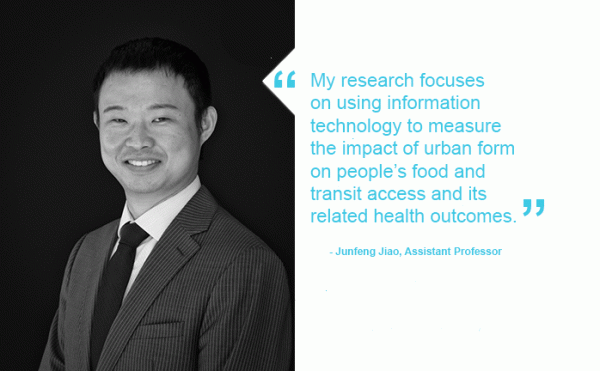Junfeng Jiao, Faculty

What program(s) are you associated with in the School of Architecture? How long have you been at the university?
I’m an assistant professor in the Community and Regional Planning Program and have been with the school for three years. I do research in GIS (geographic information systems), public health, transportation, and physical planning fields.
In what ways have you incorporated diversity and equity in your teaching and research?
My research focuses on using information technology to measure the impact of urban form on communities’ food and transit access and its related health outcomes. Two of my recent research projects (investigating food deserts and transit deserts) have been deeply connected to diversity and equity. I have developed a GIS-based method to measure access to healthy food sources using different transportation modes and socioeconomic statuses. This method can precisely identify vulnerable neighborhoods, which are in great demand for healthy food access, to help policymakers better locate limited public resources in the most needed areas. For the transit desert research, I have developed a method to quantify the gap between urban transit demand and supply for different neighborhoods. This method has been tested and applied in Austin, Dallas, San Antonio, and Houston, and I believe it will help local governments to balance out the transit gap in each city and provide better transit services to transit-dependent communities.
What does diversity mean to you?
To me, diversity means that we can constantly see, meet, and work with students and faculty from different backgrounds, ethnicities, and religions, and learn from each other.
Can you describe the sense of community at UTSOA?
The school attracts very talented students who are eager to learn from their faculty and peers. The overall student body has a deep desire and interest in sustainability and the application of information technology in architecture, planning, landscape architecture, interior design, urban design, and historic preservation. The school is a very collegial community, and the faculty often work together on research proposals, papers, design projects, and classes. They are always ready to help each other and share knowledge with colleagues and students.
What are your aspirations –big or small– for the future?
To educate the next generation of planners and designers with a strong mind in diversity, equity, and sustainability. To help UTSOA become a national leader in using information technology in architecture, planning, and all related fields.

